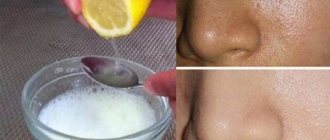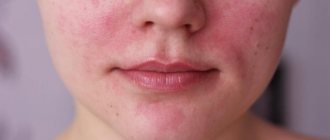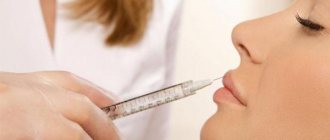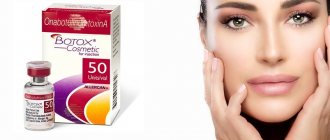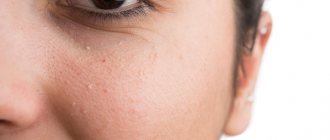Symptoms of pastiness
The word “pasty” comes from the English “dough”. It is with this that the texture of the skin of a person suffering from this disease is compared. This is due to the fact that when the face becomes pasty, the body’s water balance is disrupted. For this reason, there is a failure in the outflow of fluid through the lymphatic and venous network of the body, and the skin takes on an unattractive appearance.
Symptoms of skin pastiness are:
- swelling of the cheeks and neck;
- swelling of the eyelids;
- skin rashes;
- change in skin color;
- looseness of the skin and changes in its color;
- “jowls” - sagging cheeks;
- double chin;
- “bags” under the eyes;
- visual aging of the skin.
The places in which skin pastiness appears directly depends on the characteristics of the human body, his age and the presence of diseases.
Facial swelling associated with bacterial infection
Facial swelling can occur as a result of a bacterial infection. Such swelling can be easily distinguished by special symptoms.
With erysipelas caused by streptococci, the skin is red, clearly separated from healthy tissue, tense and shiny. In addition to local symptoms, there are systemic symptoms - fever, chills, weakness. Treatment of erysipelas consists of antibiotic therapy.
Antibiotic therapy
Swollen face, eyelids, cheeks are also symptoms of inflammation of the orbital tissue, conjunctivitis, sinusitis, salivary glands, animal scratches and boils.
Table 2. Treatment of diseases associated with facial swelling
| Group of diseases | Treatment |
| Complicated cellulitis localized on the face, caused by group A streptococcus , Staphylococcus aureus , Haemophilus influenzae , B streptococcus | First-line drugs: second generation cephalosporins; Second-line intravenous drugs: amoxicillin/oral clavulanate in combination with cloxacillin |
| Staphylococcus aureus infections CAMRSA | Trimethoprim with sulfamethoxazole, doxycycline (over 12 years), clindamycin |
| Staphylococcus aureus MRSA infections | Glycopeptide antibiotic, linezolid, daptomycin |
| Abscesses | Surgical drainage |
Reasons for appearance
The reasons for fluid retention in tissues may be as follows:
- Hydrostatic. It occurs as a result of increased pressure in the vessels, causing fluid to leak from them into the tissues.
- Hypoproteinemic. It appears when there is insufficient amount of protein in the blood, which makes it difficult for the fluid to “exit” beyond the capillaries.
- Membranogenic. The integrity of the membrane is compromised, and fluid flows freely into the tissue.
These disorders appear as a result of diseases or malfunctions of body systems.
If a person has a puffy face, the reasons may be as follows:
- diseases of the endocrine system;
- metabolic disease;
- inflammatory processes (rhinitis, sinusitis, conjunctivitis, frontal sinusitis);
- arterial hypertension;
- allergic reaction;
- cardiovascular diseases;
- osteochondrosis of the cervical or thoracic spine;
- disruption of the genitourinary system of the body;
- some medications (diuretics, glucocorticoids and sedatives);
- liver diseases;
- improper and unbalanced diet;
- helminthic infestation;
- hormonal disorders in women associated with premenstrual syndrome, menopause, taking certain medications, diseases of the pelvic organs or pregnancy;
- hypovitaminosis;
- hereditary skin characteristics;
- excessive consumption of alcohol and energy drinks. Doses for women in this case are significantly less than for men;
- low-quality cosmetics;
- excessive time at the computer;
- malignant neoplasms;
- diseases of the nervous system of the body;
- age over 30-35 years.
Children are more likely to experience pasty skin. Stagnation of fluid in tissues occurs due to developmental anomalies, dystrophy, anemia and diathesis.
Pasty facial skin in the morning in women occurs due to drinking large volumes of liquid the day before.
Diets with a low content of protein, vitamins and microelements in the diet also play a significant role in the appearance of a puffy face in women.
A puffy face in the morning is also a consequence of excessive smoking. Nicotine has a negative effect on peripheral blood vessels, causing spasms, reducing their strength and reducing the overall content of vitamin C in the body.
A puffy face occurs due to metabolic disorders or excessive consumption of salty, fried, spicy or fatty foods that retain fluid in the body.
Pasty skin is a phenomenon that indicates disturbances in the functioning of systems and diseases of the body. If a puffy face appears, you should immediately consult a specialist.
Diet
Swelling on the face in women, the causes of which lie in poor nutrition, can be prevented by changing the usual diet:
- Reducing the amount of salt - it is recommended to consume no more than 6 g per day. Salted fish, semi-finished products, chips, snacks, mayonnaise, and canned products are excluded from the diet.
- By adjusting the volume of incoming fluid - during the day you need to drink up to 2 liters of water, reducing the amount in the evening.
- Refusal of coffee, energy drinks, sweet carbonated water - use natural juices and green tea as a replacement.
- By removing fatty, fried, sweet foods from the daily menu - pastries, cakes, cookies. Large amounts of carbohydrates and sugar can cause swelling and slow metabolism.
Nutritionists advise consuming enough animal proteins along with chicken eggs, cottage cheese, fish, and lean meat. The diet should be dominated by foods enriched with potassium - melons, apricots, parsley, rice.
Don't miss useful advice from doctors about: Sinusitis: symptoms and treatment at home
Treatment
How to get rid of facial pastiness? People experiencing this condition should first seek advice from a physician. The doctor will examine the patient and may refer him to various specialists to clarify the cause of the disease, and also take blood for analysis or recommend an ECG.
Women may be scheduled to see a gynecologist.
Pastosity is also detected using the McClure-Aldrich test. In this study, 0.2 ml of isotonic sodium chloride solution is injected under the patient's skin. The resulting blister in a healthy body resolves within an hour. When the skin is pasty, the swelling goes away much faster.
The process of treating a puffy face directly depends on the cause of the pastiness. In combination with drug therapy, the patient must follow the following specialist recommendations:
- You need to watch your diet. The patient must control diuresis so that the amount of fluid consumed is equal to the volume of urine excreted by the body. Drinking any drinks is prohibited 3 hours before bedtime. The amount of salt in the diet should not exceed 3 g per day.
- It is necessary to regulate sleep and rest patterns. Sleep should be long (at least 8 hours) and with a comfortable pillow. Every day you need to be in the fresh air and ventilate the room. Incorrect positioning of the head during sleep affects the puffiness of the facial skin.
- You should do a massage that enhances the outflow of lymph and fluid.
- You need to try to unload the lower limbs. To improve venous blood flow, it is recommended to raise your legs to an elevated position at least 15 minutes before bedtime.
- You should take vitamin complexes.
To prevent recurrence of the causes of facial puffiness, women need to use high-quality cosmetics, apply them correctly and be sure to wash them off the skin before going to bed. You should try to limit the use of decorative cosmetics as much as possible.
To get rid of pasty skin, in pharmacies you can purchase specialized forms for collecting water or ready-made masks suitable for different skin types. The latter are made from seaweed extract, mineral mud, cucumber juice, green tea extract, horse chestnut, chamomile, birch leaves and other vitamins and bioactive components.
Diuretics based on medicinal herbs (bear ears, rose hips, corn silk) also help get rid of puffy skin. Such remedies not only remove fluid from the body, but also have an antiseptic effect.
What traditional medicine advises
The simplest, most accessible and safe diuretic is fresh vegetable or fruit juices. Experienced people recommend combining a quarter glass of freshly squeezed juices of carrots, cucumbers, celery and lemon. Stir the resulting mixture, add 50 ml of warm water and drink on an empty stomach. If you do this procedure every day for three weeks, you can get rid of not only swelling on the face, but also cleanse the intestines and skin of waste and toxins, and lose up to 3 kg of excess weight.
Herbal medicine is an affordable and gentle way to combat swelling on the face and fluid retention in the body
The following recipes will also help in the fight against edema:
- Mint infusion. Chop fresh or dry mint. You will need two handfuls of fresh, two tablespoons of dried. Place the mint in a thermos and pour 500 ml of boiling water, close and leave for one hour. Drink the strained infusion warm in small sips throughout the day. This remedy is suitable for combating edema in children and pregnant women.
- Flax seeds. A tablespoon of seeds is poured into a bowl, poured with a liter of water, placed on the fire, brought to a boil and cooked for a quarter of an hour. Then cover and let it brew for an hour. The infusion is drained and taken warm in small portions throughout the day. The seeds can be wrapped in gauze and applied to the swelling for a quarter of an hour as a compress. The course of treatment lasts two weeks or until swelling is completely eliminated, if it has not gone away after 14 days.
- Bearberry. Two tablespoons of bearberry are poured into 500 ml of hot water, covered and left for half an hour. Then the mixture is stirred and filtered. The infusion is taken three times a day, a third of a glass, the course of treatment lasts 14–21 days.
Important: although folk remedies are considered gentle and harmless, you should not violate the recipe and dosage. Infusions based on medicinal herbs can also cause severe allergic reactions, eating disorders and poisoning. If swelling increases, a rash appears, shortness of breath, vomiting, or diarrhea, you should immediately rinse your stomach, take activated charcoal and seek medical help.
Darsonvalization, biorevitalization, various types of massages - this is what modern cosmetology offers for its part to combat facial swelling
How to quickly remove pasty facial skin?
If the appearance of a puffy face is not associated with diseases, then ice lotions, compresses with strong tea leaves or salt will help get rid of it.
The method of contrast application is also considered effective. It consists of placing two containers with hot and cold water in front of the patient. The towel is first moistened in boiling water and applied to the face until it cools completely, and then immersed in another container and laid on the skin for 40 seconds. This alternation must be repeated 4 times.
Using traditional medicine recipes, you can get rid of pasty skin using decoctions of chamomile, plantain, birch buds and green tea.
The most common methods of dealing with puffy skin at home are masks made from raw vegetables or mashed potatoes. They need to be done several times a day until the puffiness of the facial skin gets rid of.
In cosmetology, to get rid of skin pastiness, there are physiotherapeutic procedures (lymphatic drainage, biorevitalization, microcurrent therapy, etc.) and professional masks.
Important! You should make and apply masks and compresses according to traditional medicine recipes only after consulting a doctor.
Massage
A massage to relieve facial skin pastiness is carried out exclusively with your fingertips along massage lines in the morning. You need to do it starting from the cheeks. The direction of movement is from the cheekbones to the lower jaw.
The forehead massage is carried out from the bridge of the nose towards the temples along the superciliary arches. The area around the eyes is treated carefully along the skin over the bones from the inner to the outer edge of the eye. After this, the cheekbones are massaged from the wings of the nose to the ears.
Massage has a tonic effect on the tissues and vessels of the face and increases the outflow of fluid from the tissues, which helps to get rid of skin pastiness in the shortest possible time.
Prevention of facial pastiness
In order not to encounter facial pastiness, you should follow a number of simple rules:
- give up all bad habits;
- avoid stressful situations and treat diseases of the nervous system;
- eat properly and balanced, include in your diet food containing sufficient amounts of proteins, carbohydrates, vitamins and microelements;
- you need to monitor your health and control your weight;
- undergo regular examinations by specialists;
- It is recommended at any age to use the services of a cosmetologist or do facial massage and nourishing masks at home.
The causes of pasty facial skin can be both minor and serious diseases. Therefore, it is very important to closely monitor your health and lifestyle.
The article was verified by an expert - beauty blogger @lil4olga.
Many people are concerned about swelling of the face in the morning, which can appear in girls and women, boys and men. It is accompanied by pallor, decreased skin elasticity and doughy tissue.
Without understanding the reasons, people use various advice from friends and local home remedies to eliminate swelling. However, these measures often do not have the expected effect.
Cardiovascular diseases
We continue to consider the reasons why the face and eyes swell. Some heart diseases can manifest themselves in the form of swelling in the eye area, in parallel with this, the legs in the area of the ankles and lower legs swell, especially in cases where the patient had to stand for a long time. During examination of the peritoneum, fluid accumulation is diagnosed. However, swelling of the face in the morning with diseases of the heart and blood vessels may be accompanied by other symptoms, for example:
- Soreness in the heart.
- General weakness.
- Increased contraction frequency of the heart muscle.
- Small vascular network on the skin of the face.
- Violation of the frequency and depth of breathing, in which a person feels a lack of air.
Vascular diseases are accompanied by pallor of the skin, its bluish tint, as well as puffiness under the eyes. At the same time, impaired outflow of venous blood can make swelling one-sided. If the cause of swelling of the face and eyes lies in these ailments, then at the same time dizziness and a sharp drop in blood pressure may occur. Patients often also experience cold extremities.
Treatment of swelling of the face and eyes, the cause of which is vascular and heart disease, requires a competent approach and monitoring the patient’s condition. The drugs will be prescribed depending on the specific type of pathology: Bequorin or Hypothiazide are used as diuretics, Enalapril or Ramipril are prescribed as antihypertensive drugs, and Strophanthin K is prescribed as cardiac glycosides.
Please note that the face and eyes often swell during a stroke. The cause of swelling in this case is very common
Now let's take a closer look at what else, in addition to diseases, can provoke this symptom.
Causes of facial swelling
General principles of edema formation
Water makes up on average 70% of body weight. The main part of it is in the cells, the rest (about 30%) is part of the intercellular (interstitial) fluid and takes part in metabolic processes, and associated with hyaluronic acid - in providing tissues with firmness, elasticity, maintaining volume and shape.
In a healthy body, the composition, distribution and volume of intercellular fluid are relatively constant. By diffusion, water enters tissues from the blood and back through the wall of capillaries and small vessels, which is a semi-permeable membrane. In addition, the outflow of excess water from tissues occurs not only through the venous system, but also through the lymphatic vessels.
A certain constant ratio of protein fractions with normal permeability of the vascular wall retains water in the bloodstream. At the same time, excess salts, mainly sodium ions, easily penetrate through the walls of small vessels into the tissue, dragging it along with it.
The rate of diffusion and fluid outflow is affected by:
- the difference between osmotic (salt) and oncotic (protein) pressures of blood and interstitial fluid;
- degree of permeability of the walls of capillaries and venules;
- hydrodynamic pressure in the bloodstream.
Any of the above reasons can lead to local edema or pastosity (barely noticeable swelling) if the outflow of fluid through the lymphatic or venous network is impaired. Regulation of water-salt metabolism is carried out by the nervous-endocrine system, and the development of edema is directly related to the retention of sodium salts in the intercellular fluid, which, in turn, retain water. These processes are influenced by the immune system, kidney, liver, lung and heart function, vascular condition, hormonal disorders in diabetes mellitus, hypothyroidism, and adrenal tumors.
The localization of edema depends on the anatomical features of a particular area of the body, its position in space (vertical, horizontal) and the type of disease. Pastiness first of all appears in the morning and on the face, especially on the eyelids. This is explained:
- prolonged horizontal or incorrect position of the body during sleep, which contributes to the redistribution of fluid to the soft tissues of the face;
- lack (at night) of activity of facial muscles for a long time, as a result of which blood flow in the venous network slows down and lymphatic drainage worsens;
- the smallest, compared to other areas, thickness of the skin and subcutaneous fat layer.
Main reasons
Thus, swelling or pastiness of the face can be caused by both general causes in the body and negative local processes:
- diseases of internal organs and disorders of the endocrine system (hypothyroidism, hypoparathyroidism, diabetes mellitus, hypothalamic-pituitary syndrome), leading to fluid retention in tissues;
- tissue characteristics due to hereditary predisposition;
- helminthic infestation (most often roundworms or pinworms), leading to a general immune reaction to toxins and antigens of parasites;
- allergic predisposition in general and in particular to dust mites, house dust, which accumulates in soft toys, bedding, etc.; an allergic reaction causes swelling of the mucous membrane of the eyes and nose, disruption of the outflow of tears through the nasolacrimal canal, difficulty in nasal breathing and the occurrence of swelling of the eyelids, pastiness (puffiness) of the entire face;
- arterial hypertension, taking antidepressants, glucocorticoids and sedatives;
- the presence of chronic inflammatory processes in the facial area - rhinitis, sinusitis and sinusitis, conjunctivitis;
- osteochondrosis of the cervical and upper thoracic spine with chronic pain syndrome leading to muscle spasm, circulatory disorders and deterioration of the outflow of blood and lymph from the head;
But edema is not always a consequence of pathological conditions. They can appear for quite common reasons:
- Facial swelling in women can be associated with the menstrual cycle, especially in the second half, with pregnancy, as well as with the use of certain oral contraceptives, with improper use of cosmetics or their poor quality.
- Age-related changes in the body after 30-35 years, accompanied by a decrease in the content of hyaluronic acid, which binds water, and an increase in free water in tissues.
- Diets for weight loss and consumption of foods low in proteins, vitamins and microelements, which leads to an increase in the permeability of the vascular wall and a decrease in oncotic pressure in the blood vessels.
- Excessive consumption, especially in the afternoon, of liquids, spices and salt in pure form and as part of food products (sausages, cheeses, smoked meats, pickles, marinades, ketchup and other seasonings, canned fish).
- Smoking - nicotine causes spasm of peripheral blood vessels, a decrease in the content of vitamin C in the body and an increase in vascular permeability.
- Frequent consumption of various energy and alcoholic drinks.
- Long-term work at the computer, sleep disturbances, psycho-emotional overload, chronic fatigue syndrome.
- Incorrect head position (low or uncomfortable) during sleep.
- Long-term use of diuretic pharmaceuticals or medicinal herbs with a diuretic effect to reduce swelling. Over time, this leads to electrolyte imbalance and the opposite reaction - compensatory fluid retention in the tissues.
Swelling of the forehead and its causes
Almost everyone has experienced such a condition as swelling at least once. Some do not attach any importance to it, but for others it is a serious problem. So in what cases should you worry, especially if there is swelling of the forehead, eyes, or other parts of the face, and when should you not worry too much about this?
If the face suffers
For women, this is a very pressing problem, and it is necessary to understand the reasons and get rid of it; appearance suffers first of all. Knowing that there is a predisposition to swelling, it is important to know how to avoid it. In what cases does fluid accumulate?
Drinks that remove water from the body (tea, coffee). They have a diuretic effect, and this is a signal to accumulate it.
Consumption of salty foods. It is salt that is able to retain liquid, which is why thirst is so common after eating salty foods.
Lack of pure water. When drinking various drinks, the body accumulates water for future use.
It all depends on how and at what time the swelling appeared. If it is a blow, it always provokes swelling in the affected area of the forehead or eyes, so depending on the severity of the injury, a number of measures must be taken to eliminate or prevent severe swelling of the eye.
After a blow, there is always a lot of blood on the forehead and in the bridge of the nose if the skin is cut. But there are cases when hematomas form, and it is not worth leaving the victim without medical care, as there may be serious consequences.
Injury
Any injury is insidious, and even if there is no particular damage, this does not mean that everything is in order. As for the child, he is exposed to constant risks, since for a long period he walks poorly, then moves a lot, and experiences one blow after another. Most often, the forehead and eye are affected, swelling of the eyelids occurs immediately after the blow, the eyes become swollen, and urgent help is required.
First of all, it is necessary to localize the swelling and its spread. Applying a cold compress can significantly reduce the size and severity of swelling. What you apply to relieve symptoms should be gentle. If you don’t have such an object, then an ice cube will do; you can use it to wipe the place of impact on your forehead or nose. A towel dampened with cold water will do.
It is difficult to persuade a child to endure the cold in the area where the blow was struck, whether it is the forehead or another part of the face. But this must be done, since even a short-term compress will help avoid bruises and relieve swelling.
But not only a blow can cause this condition; there are a number of diseases that cause swelling of the eyes, eyelids, and forehead.
For example, thrombosis of the cavernous sinus causes such symptoms, and at the first signs of the disease it is imperative to consult a doctor.
All infections in the eye and nose area can significantly disrupt the fluid balance; this can be sinusitis, sinusitis, inflammation of the tonsils, lymph nodes, even teeth.
For example, stye in the area of the eye and eyelids appears quickly, and by using special means in time, you can quickly get rid of it. The main thing is to know what these means are and how to use them.
Why does this condition occur?
The reasons why swelling occurs can be very different, and by understanding how it occurs, you can effectively treat it, although it is quite difficult to remove the swelling. Excess fluid and blood, which may appear if there was a blow, accumulates in the area of the eyes, eyelids, forehead, a feeling of discomfort arises and there may even be pain.
The reasons may be as follows:
- cardiovascular diseases;
- various injuries to the forehead, eyes, nose;
- chronic malnutrition;
- alcoholism;
- renal failure;
- surgical intervention;
- if tattooing was performed;
- medicines;
- chronic diseases;
- allergic reaction.
When determining the reason why a particular part of the face swells, it is important to consider many factors. First of all, how quickly it goes away, at what time of day the feeling of discomfort occurs, and if it is an allergy, identify the source of the trouble. Even after sunbathing, similar problems can occur.
Drinking alcohol always gives an unfavorable picture in the morning, and heart problems seriously disrupt fluid exchange in the body, stagnation occurs and, as a result, a state of swelling. When undergoing plastic surgery, swelling is an inevitable companion; the skin takes some time to recover, and this is a rather painful process.
Some are addicted to tattooing, which also affects the condition of the eyelids, or their eyes suffer. Eyebrows, lips, eyes are corrected, and all this certainly leads to a condition where the face swells. A correctly and competently performed procedure minimizes the risk; a good specialist will not allow inflammation or other complications.
Since swelling is strongest after an impact, applying cold can prevent hemorrhage; blood vessels and capillaries do not have time to burst. If in the first minutes after the blow there is nothing cold at hand, then applying a compress later is useless.
In order to relieve the effects of swelling after an injury, you can use lotions from herbs such as:
- plantain;
- St. John's wort;
- tramp.
They are infused according to the recipe and applied to the eye area, eyelids, or on the forehead. Among folk remedies, doctors recommend wiping the area where the swelling appears with vinegar or onions. These products can both reduce pain and disinfect the wound.
If it is not immediately possible to see a doctor, then after providing emergency assistance, this must be done at the first opportunity.
The doctor will rule out a concussion, check the body’s response to certain manipulations, and prescribe effective treatment.
Very often during the summer holidays, women have a problem with prolonged exposure to the sun. Swelling can occur after sunbathing and affects the eyelids and eyes. At the same time, the appearance suffers greatly, and it is not easy to relieve the symptoms.
The reasons that cause this condition can be either prolonged exposure to the sun to acquire a tanning effect, or excess fluid intake. You need to take sunbathing with caution, only in the first half of the day before 11 o'clock and after 16-00 the sun will not burn or dry out the skin. An even and beautiful tan can be achieved only by gradually accustoming the body to warmth and sunlight.
Complications
After a blow, there may be complications that only a specialist can identify. A doctor can understand the causes of eye swelling and help relieve pain. The area of the bridge of the nose and eyes is the most sensitive area; most often it is in these places that bruises and hematomas appear. An ointment, Heparin or Troxevasin, will help get rid of them; an iodine mesh and a compress with magnesium will be useful.
If a lump appears, you should watch how quickly it grows. If it does not go away for a long time, then you must consult a doctor. But none of these ways to get rid of swelling and bruising will help within 24 hours. It will take at least four days to get rid of this problem.
Source: https://pro-oteki.ru/lico/lob
Treatment of facial swelling
Facial pastiness should not cause much concern in acute respiratory diseases, since with recovery the causes that led to it disappear. However, if it persists for a long time after a cold or occurs for no apparent reason, you should consult a general practitioner.
This is due to the fact that many diseases of internal organs (glomerulonephritis, pyelonephritis, myocarditis, diabetes mellitus, hypothyroidism, helminthic infestations, systemic autoimmune diseases, etc.) can occur in a mild or chronic form. To determine the causes of pastiness of the face and eyelids in these cases, differential diagnosis through a thorough examination is necessary.
Possible causes of facial swelling
Below are the most common causes of facial puffiness.
Actinomycosis
Facial swelling should be assessed by a doctor
Actinomycosis is a rare and potentially dangerous chronic bacterial infection that causes swelling and abscesses in the soft tissues of the body. This condition usually affects the mouth, nose, throat, stomach and intestines.
Other symptoms of actinomycosis include the following:
When treating people with actinomycosis, doctors usually prescribe large doses of the antibiotic penicillin. If the patient is allergic to this drug, he will be offered remedies with a similar effect. Sometimes people have to undergo treatment for several months to completely get rid of the infection, but it should be understood that actinomycosis is a non-contagious, that is, non-contagious disease.
Allergic conjunctivitis
Allergic conjunctivitis is an inflammation of the eye that develops as a result of an allergic reaction. Allergens include the following:
- dust;
- mold spores;
- pet hair;
- pollen.
The main symptom of this condition is reddened and moist eyes, in which there is a burning sensation and itching. The skin around the eyes may become swollen, especially after waking up.
For any form of conjunctivitis, it is important not to rub your eyes, as doing so can make symptoms worse.
People can prevent allergic conjunctivitis by avoiding allergens. Treatment for this condition involves applying cold compresses to the inflamed areas and taking medications such as antihistamines and anti-inflammatory or steroid eye drops.
Anaphylactic shock
Anaphylactic shock is an acute allergic reaction. This is a medical condition that can be fatal and therefore requires immediate medical attention. Symptoms tend to appear soon after the body interacts with allergens, and their severity quickly worsens. Symptoms of anaphylactic shock include the following:
- labored breathing;
- diarrhea;
- swelling of the face;
- urticaria (red, raised, itchy rash);
- itching;
- loss of consciousness;
- nausea and vomiting;
- cardiopalmus;
- sudden drop in blood pressure.
If a person experiences symptoms of anaphylactic shock, they should seek emergency medical attention immediately.
Angioedema
Angioedema is swelling that occurs as a result of an allergic reaction to food, medications, or other allergens such as insect bites. In addition to facial swelling, symptoms of angioedema include the following:
Mild angioedema does not always require treatment, although in such cases exposure to allergens should be avoided. For moderate to severe symptoms, the use of epinephrine, antihistamines, or other medications may be necessary.
Home care methods include using cold compresses and wearing loose clothing.
Nose fracture
Various traumatic episodes can cause a nasal fracture. Such damage can also lead to facial swelling and other symptoms, such as:
- crooked nose;
- bruising;
- nosebleeds;
- pain.
A nasal fracture does not always require medical attention, but people should see a doctor after any facial injuries. Treatment usually involves taking painkillers, splinting, and applying cold compresses. Some patients in such situations require surgery.
Cellulite
Antibiotics help treat cellulite
Cellulite is a bacterial skin infection that causes redness, swelling and local fever in the affected areas. Cellulite can also cause pain. Without treatment, this condition can be life-threatening.
Signs of an acute infection include the following:
- fever;
- chills;
- red streaks extending from the rash.
To treat cellulite, doctors usually prescribe antibiotics, which patients take for at least five days. Painkillers and complete rest for the body also help reduce discomfort.
The bridge of the child’s nose, the forehead between the eyebrows and the eyes are swollen - what is the cause of the swelling?
Swelling of the bridge of the nose and the area between the eyebrows is not a harmless phenomenon. This may be a manifestation of a hematoma after a blow, the spread of inflammation deep into the nasal sinuses during rhinitis, or a reaction to an allergen. Parents should take this symptom seriously, especially if the child is small and cannot explain what is happening to him.
Facial swelling in children is a cause for concern
The danger of swelling in the area between the eyebrows is the risk of breathing problems. Also, inflammation can spread from the frontal sinuses to the brain due to its close location. In addition, the inflammatory process can spread to the eyes with the appearance of severe symptoms and dangerous complications.
Pain and burning, breathing problems cause stress in the baby, which negatively affects the nervous system. A hysterical state aggravates the course of the disease. Breastfed babies have difficulty sucking and breathing at the same time when they are swollen, so they may become malnourished and not gain weight. A weakened child gets sick longer and has a harder time recovering.
Why is the bridge of my nose swollen?
Swelling of the bridge of the nose is usually a manifestation of an inflammatory process, which can have many causes:
- Inflammation of the nasal mucosa (infectious, vasomotor, allergic rhinitis). In the acute phase, swelling is noted, in the chronic phase, tissue growth occurs due to pathological cell division (proliferation).
- Sinusitis (inflammation of the paranasal sinuses). Its types are sinusitis (inflamed maxillary sinuses), frontal sinusitis (frontal sinuses are affected), their combination with inflammation of the ethmoid bone (frontoethmoiditis, maxillary ethmoiditis).
- Foreign body inside the nose. The area around it becomes inflamed, the body reacts with an accumulation of white blood cells (pus).
- Injury to the bridge of the nose. When struck, a hematoma (consequence of internal bleeding) and swelling with blue (sometimes black) under the eyes occur.
- Congenital or traumatic curvature of the nasal septum or anatomical narrowness of the canals. The breathing process is difficult, the mucous membrane easily becomes inflamed and swollen.
Swelling is a consequence of injury
Damage to soft tissue and blood vessels can occur due to impact or fracture of the bones of the nose and upper jaw. Bone fragments further destroy them, preventing rapid healing and reducing swelling.
A comminuted fracture may require surgery. After this, the bones are fixed for several days by packing the nose. Sometimes, when the jaw bones are fractured, the lips are fixed with staples and the patient is given only liquid food.
For any injury to the nose, it is advisable to take an x-ray to check the condition of the bones. A fracture that does not heal properly will cause breathing problems and recurring swelling in the future. If the nose is injured, cold should be applied to the damaged area to prevent swelling.
Foreign body in the nose
When a small child explores the world around him, he “tastes” things - he tries to put them in his mouth or nose. These can be small parts of toys, peas and even tablets. In nature, insects, poplar fluff or dandelion seeds can get into the nasal passages.
When swimming, microorganisms living in the water can crawl in. The task of parents is to organize the space for children in such a way that small objects and medicines are out of their reach.
It happens that during medical procedures a fragment of a tampon or a piece of an instrument remains in the nose.
The presence of an object in the nose impairs the ventilation of the sinuses, leading to an inflammatory process (even suppuration) and swelling. If the object is not removed for a long time, polypous tissue growths, dysfunction of the lacrimal process, suppuration and swelling of the conjunctival sacs are possible. The presence of a foreign object can be indirectly determined by the release of exudate from the affected nostril.
Complication of conjunctivitis
Conjunctivitis of viral or bacterial origin often occurs in children during seasonal epidemics. Children attending nurseries and kindergartens are especially susceptible to them.
They occur in combination with rhinitis and sinusitis, cough, and fever. Inflammation of the conjunctiva and nasal mucosa can cause swelling of the eyelids and nasal area.
The baby's condition is aggravated by a painful and uncomfortable eye condition.
Why does my forehead swell?
Swelling of the forehead often has the same etiology as swelling of the upper part of the nose. It occurs as a result of the penetration of inflammation into the frontal sinuses or as a reaction to injury to both zones. Swelling of the forehead without swelling of the bridge of the nose can be a manifestation of contact dermatitis, an insect bite, sunburn, or a pinpoint injury.
Allergic reaction
As a rule, contact dermatitis occurs when the surface of the skin comes into contact with an allergenic substance. If your forehead is swollen, it may be a reaction to creams, ointments, liquid repellents, or fabric headgear. The symptom is accompanied by itching and redness of the skin. It can be eliminated with the help of external antihistamines containing corticosteroids.
A bite of an insect
Bites from large insects that inject venom into the wound cause particularly extensive swelling. These could be wasps, bees, gadflies. Multiple bites from mosquitoes and other mosquitoes, especially midges, can cause swelling of the entire face.
Midges bite off part of the flesh and inject hemolytic poison into the wound with their saliva, which causes an allergy in many people in the form of simulidotoxicosis. It is manifested by swelling, itching, the appearance of papules, hyperemia (excessive blood flow into the tissues).
When you are in places where midges live, you need to wear mosquito nets under your hats and use repellents.
Kidney disorders
With renal failure, fluid retention in the body and changes in blood composition occur (decreased protein levels, increased concentration of Na ions, toxins). This leads to swelling of the upper torso, eyelids, and area around the eyes. With swelling of the upper eyelids, the swelling extends to the brow ridges.
Renal edema can be distinguished by its mobility (when pressure is applied, it moves), pale color and normal body temperature. Indirect signs: small amount of urine excreted, deviations in its composition, lower back pain.
Other causes (tumors, skin diseases)
Sunburn, frostbite, and exposure to hot air can also cause swelling on the forehead. It will pass when damaged cells are regenerated.
In adolescents, at the onset of puberty, the sebaceous glands produce excessive amounts of sebum. This often occurs on the face, especially the forehead. When the sebaceous gland cannot cope with the removal of fat, a cyst or atheroma (a bag of sebum) appears under the skin, which looks like swelling. Sometimes cysts transform into abscesses, and in their place boils filled with pus appear.
Swelling on the forehead and bridge of the nose can be caused by a bone growth (osteoma), a fatty deposit (lipoma), or a basal cell tumor on the skin of the forehead and nose (carcinoma). Tumors of various etiologies, cysts in the nasal area cause narrowing of the respiratory passages from the inside and swelling from the outside.
When should you see a doctor?
You should see your doctor if facial swelling does not go away after a few days, or if the problem is accompanied by other symptoms, such as pain, redness or itching.
Emergency medical care should be called if a person experiences symptoms of anaphylactic shock, or if they have been exposed to dangerous allergens or have been bitten by a poisonous insect.
Urgent medical attention should be sought if symptoms of superior vena cava syndrome develop. Those people who have been diagnosed with cancer, as well as their relatives, should be well aware of these symptoms.
Prevention
Not all causes of facial swelling can be prevented, but the following recommendations may help:
- avoid known allergens, including problematic foods and medications;
- Maintain good oral hygiene by brushing and flossing regularly to avoid tooth and gum infections;
- Eat a healthy diet and reduce stress to stimulate the immune system, which protects the body from infections that cause swelling.
What diseases can cause swelling?
Keep in mind! Swelling of one eyelid is a characteristic symptom of any of the following diseases of the organs of vision:
- Barley. When the disease occurs, an abscess forms on one of the eyelids (in the place where pathogenic microflora enters the eyelash follicle). In such situations, the patient experiences pain, redness of the skin of the eyelids, and sometimes an increase in body temperature and a feverish state. The swelling subsides as soon as the mature abscess disappears and the purulent contents come out of it.
- Conjunctivitis. This disease can develop for various reasons, but almost always one of its signs will be severe or mild swelling of the eyelid. Swelling can develop only in one eye and be completely absent in the other, but most often both organs are affected at once (or at most with a difference of one or two days).
- Dacryocystitis. With this disease, obstruction of the lacrimal canaliculus occurs, which almost always occurs only in one eye - it will become inflamed with this kind of blockage. The disease can occur in acute or chronic form, and if in the first case the swelling can be severe, then in the second it will be moderate. In addition to swelling, the disease is characterized by the discharge of purulent masses from the affected canal when pressed.
- Blepharitis. In the unilateral form of the disease, swelling affects only one eye, and such cases are quite common. In addition to pain, redness and swelling, the disease is characterized by loss of eyelashes on the affected eyelid. In an advanced form, pathological processes spread to the conjunctival membrane of the eye, as a result of which visual functions are impaired.
Unilateral swelling is possible with any inflammation of an allergic nature, when the role of an allergen can be played by food, animal hair, plant pollen and components of certain medications.
In this case, the main treatment should be preceded by identifying the allergen and eliminating contact with it.
Important! After this, symptomatic antihistamine therapy is required, including the use of decongestants for local and oral use.
